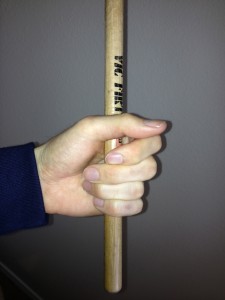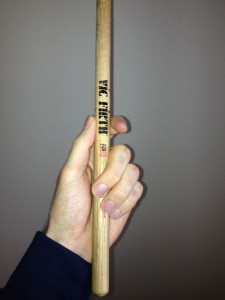If you are looking for ways to change up the paradiddle accents then check out this video. It implies you have a good understanding of how to play the paradiddle with the Moeller technique. If you need a refresher, you can check out the Paradiddle speed builder lesson.
Tag Archives: Natural Drumming
Moeller Traditional Exercise 2
Download Moeller Traditional Exercise 2 PDF
I’m exaggerating the upstrokes using a forearm rotation and then stoping at the top (so the stick tip faces up.) I’m exaggerating the movements to make it easy to see the forearm rotation.
I’ve noticed that if you utilize forearm rotation on the upstroke it makes it natural to unwind the forearm rotation to produce the downstroke.
I originally learned Moeller playing matched grip and without forearm rotation. After playing professionally for a few years I developed tendonitis in my right shoulder due to overusing muscles in arms and shoulders while playing at high volumes.
I revisited my technique and developed the Moeller with forearm rotation as well as focusing on just the wrists and forearms to create the whip. My wrists and forearms got stronger and I was able to produce the same high volume sounds without the stress in my shoulder joints. This helped alleviate my discomfort.
I now play the Moeller with and without forearm rotation. I like to utilize forearm rotation to produce loud volume snare and tom hits. However, when I’m playing at lower volumes I just use mainly the wrists and fingers without the forearm rotation.
If your experiencing any overuse issues it might be useful to develop your Moeller with forearm rotation. However, more importantly is to play relaxed without holding any tension in your neck and shoulders.
Moeller Traditional Exercise 1
Download Moeller Traditional Ex1 PDF
In the above video I’m demonstrating the moeller exercise as written in the PDF using matched grip. I like to call this traditional Moeller because of the utilization of the pinky and ring finger grip (Sanford Moeller’s preferred grip) as well as the forearm rotation.
In Sanford Moeller’s book “The Moeller Book” he describes just three strokes–down stroke, up stroke, and the single stroke–which we now call taps. Notice in the video at the very slow tempo the down strokes and up strokes are almost identical movements. Both are similar wavelike movements. Actually, the only difference between the two is the stick makes contact with the head during the up stroke; the downstroke gets close to the head but does not make contact.
Forearm rotation was a key element in the snare drum technique that Jim Chapin and Sanford Moeller taught. I initially learned Moeller in matched grip but without the forearm rotation. Around a decade later, when I studied with Jim Chapin I realized what I was doing wasn’t actually what Sanford Moeller taught. My wrists, arms and especially shoulders were all working harder than they had to. I realized that whipping a downstroke using forearm rotation reduced my shoulder joint stress (I’ll expand more on that in a future video post).
In the video the forearm rotation is easy to see at the slow tempo. It’s still there at the faster tempo but it’s a smaller movement-like flicking water off your fingers.
If your a drummer that’s experiencing muscle overuse issues or curious about incorporating this forearm rotation into your technique feel free to download the PDF above to get started.
Moeller and Open Close Basic Exercises
Download Moeller Hybrid Ex1 PDF
I’ve been focusing on stick control with a few dedicated students so I thought why not make a video of some of the exercises? The video above shows two exercises. The first version of the exercise is a Moeller Hybrid because it uses techniques popularized by both Sanford (Gus) Moeller and George Lawrence Stone. The quarter notes are played using a variation of Moeller’s little finger grip. Just grip the stick toward the butt end with your pinky and form a loose fist with your remaining fingers.

Little Finger Grip
The purpose of this practice grip is to make it easier to feel the stick’s rebound as a jolt of electricity–not for playing the kit. I’ve been using this grip with full strokes to help students internalize their stick-rebound timing with forearm rotation. The rest of the exercise is played with a middle finger fulcrum grip that utilizes the pull out/whip without forearm rotation, which is why I call it a Moeller-Hybrid.

Middle Finger Fulcrum Grip
The second version is the same exercise but uses open/close technique (also known as push/pull). This technique was popularized by Billy Gladstone and more recently by Gordy Knudtson. Both exercises were played in matched grip with slightly exaggerated movements.
